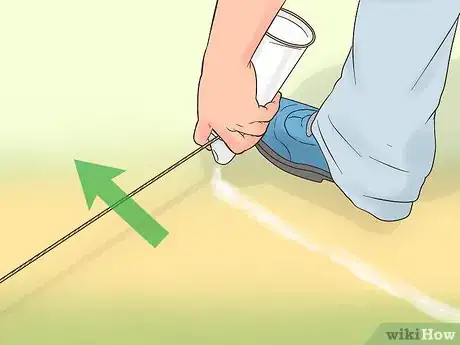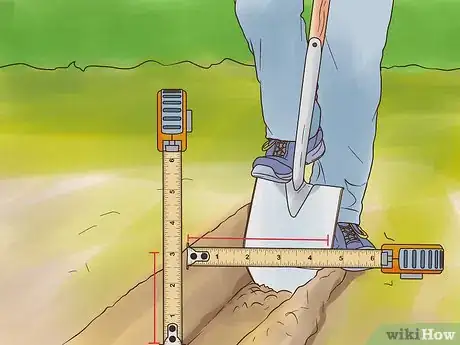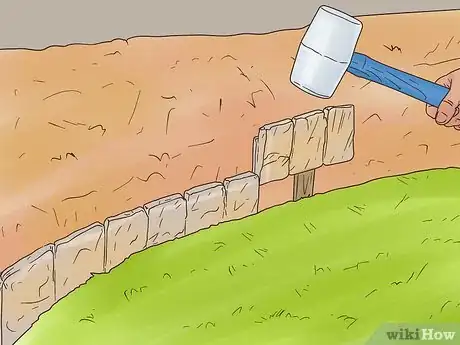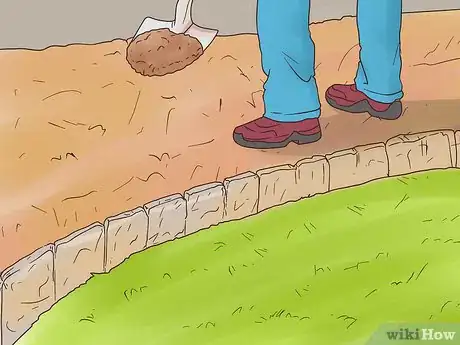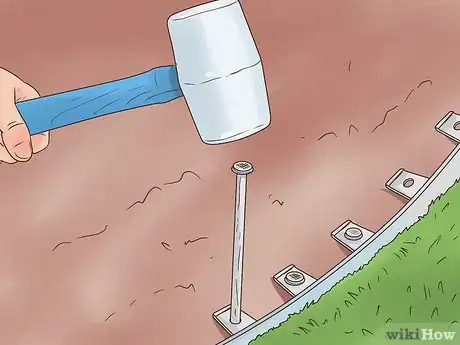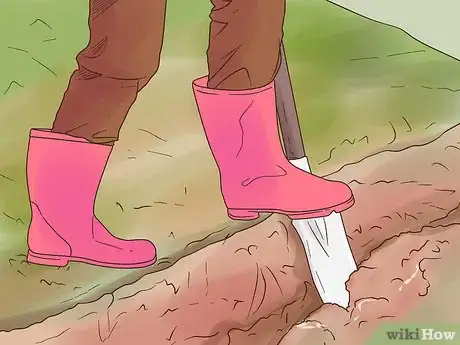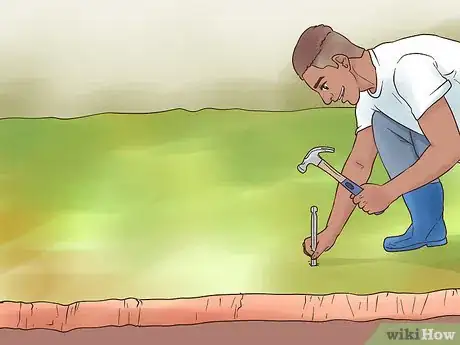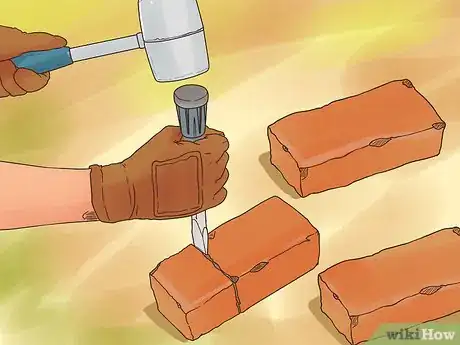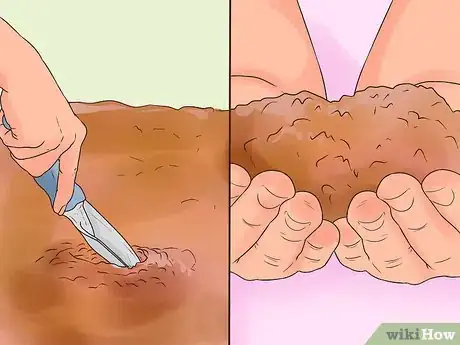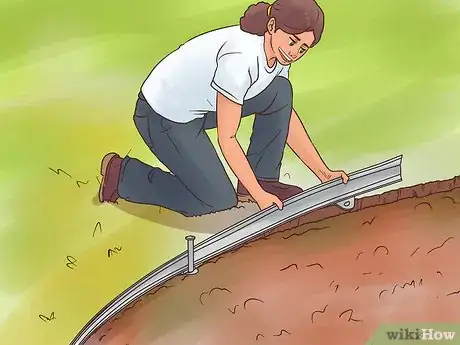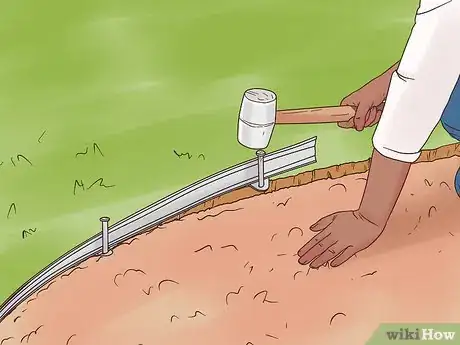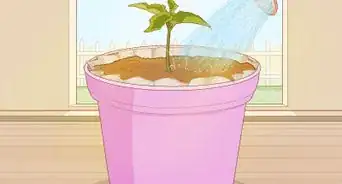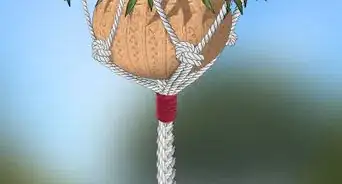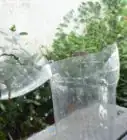This article was co-authored by Tony Hoang. Tony Hoang is a Landscaper and the Principal at H&J Landscaping & Concrete Contractor in Newark, CA. With over six years of experience, he specializes in designing the perfect concrete driveways & backyard patios for homes. H&J Landscaping & Concrete Contractor is a 4.5-star business on Yelp.
There are 7 references cited in this article, which can be found at the bottom of the page.
This article has been viewed 17,328 times.
Landscape edging can give planters and gardens an attractive, organized appearance. If you want to install landscape edging on your property, you’ll probably use either plastic, brick, or metal edging. No matter what you choose, you’ll need to decide on a perimeter and dig a trench for the edging to go into. Then, secure the edging with stakes if necessary.
Steps
Installing Plastic Edging
-
1Mark the area with spray paint. Use an old garden hose to mark the perimeter of the area you want to edge. Once it’s laid out in the shape and size you want, spray paint the ground around the outside edge of the perimeter.[1]
-
2Dig a trench with a spear-headed shovel. Use the shovel to start digging a trench along the spray painted line. Make sure the trench is 4–6 inches (10–15 cm) wide and 3–4 inches (7.6–10.2 cm) deep so that the edging can be properly installed and secured. Fill the bottom of the trench with about 1 inch (2.5 cm) of sand and pack it down so that it’s smooth and level.[2]
- Loosen the soil as you dig to make the ground ready for landscaping.
Advertisement -
3Place long strips of edging into the trench and stake them. If you’re using plastic edging in the form of long, flexible strips, take a segment and place it into the trench horizontally. Then, hammer 3–4 inches (7.6–10.2 cm) stakes into the ground every 5 feet (1.5 m) along the inside of the edging at a 45-degree angle, so that the bottom of the stakes hold the edging in an upright position.[3]
- Edging should be at least 5 inches (12.7 cm) wide for the best aesthetic appearance. Aim to have .5 inches (1.3 cm)of the edging visible above the ground.
-
4Backfill the area around the edging. Use soil, mulch, or rocks to fill the trench in the rest of the way on both sides of the edging. This will help the edging stay upright and in place.[4]
- Water the soil on all sides of your edging to help cement the edging into place.
-
5Place short pieces of edging in the trench and interlock them. If your edging is made up of interlocking panels, place a piece inside the trench vertically. Get another piece of edging and connect one end to the previous piece. Continue adding pieces in, connecting them, and backfilling as you go until the whole trench is filled.
Edging with Brick
-
1Lay out a bed and dig a trench around the edges. Lay out the borders of the garden or planter that you want to create. Dig out the inside and fill it with soil, or whatever medium you wish to use. Use a spade to dig a trench for the edging to go into. Then, pack down the trench bottom with scrap lumber so that it’s flat.[5]
-
2Insert 2 stakes and string a level mason’s line. Hammer stakes that are about 4–6 inches (10–15 cm) long into the ground at either end of the trench. Tie or hook mason’s line to the top of one stake and walk it to the other stake. Hold the twine taut and tie or hook it to the other stake. Put a brick in the trench and hang a line level from the twine to make sure it’s level.[6]
-
3Set each brick with a mallet and backfill as you go. Use the mason’s line as reference while you place the bricks in one at a time. For each one, pound the top with a mallet and fill in the space left in the trench around the brick with soil, rocks, or mulch. Continue this until the entire trench is filled in with bricks.[7]
- Water around all the your edging to help bring the components together.
-
4Cut a brick with a brick chisel if necessary. If the perimeter of your bed is a little too long or short, you may need to cut a brick to complete the edging. Measure the length of the space that still needs to be filled with the edging and mark the length on a brick. Position a brick chisel on top of the mark and strike down forcefully to break the brick. Use this piece to fill in the last bit of the trench.[8]
Using Metal
-
1Test the soil’s softness. Use a small gardening shovel to dig up some of the dirt where you’re planning on installing the edging. If it feels soft in your hands, then you may be able to simply push the edging into the ground. If not, you may need to dig a trench for it.[9]
-
2Insert steel or aluminum edging 2–3 inches (5.1–7.6 cm) into the ground. If the soil is relatively soft, use a block of wood to pound your steel or aluminum edging into the ground. If the soil is hard, use a shovel to dig a slim trench where you want your edging to go.[10] Each time you place a new piece into the trench, overlap the previous piece by about 1 foot (0.30 m) so that the edging appears connected.[11]
- If you want to create a garden or planter with a straight-edged perimeter, opt for edging that’s made of steel, as it’s very strong.
- If you’re hoping to create a curvy perimeter, go for treated aluminum edging.
-
3Hammer metal stakes into the ground on either side of the edging. Secure the edging by hammering 4–6 inches (10–15 cm) stakes into the ground on the inside and outside of the edging every 2–3 feet (0.61–0.91 m). This should keep the edging strong and stable.[12]
- To make installation easier, get metal edging that comes with anchors or slots for staking.
- Water all around your edging once it is in place.
Expert Q&A
-
QuestionHow tall should my landscape edging be?
 Tony HoangTony Hoang is a Landscaper and the Principal at H&J Landscaping & Concrete Contractor in Newark, CA. With over six years of experience, he specializes in designing the perfect concrete driveways & backyard patios for homes. H&J Landscaping & Concrete Contractor is a 4.5-star business on Yelp.
Tony HoangTony Hoang is a Landscaper and the Principal at H&J Landscaping & Concrete Contractor in Newark, CA. With over six years of experience, he specializes in designing the perfect concrete driveways & backyard patios for homes. H&J Landscaping & Concrete Contractor is a 4.5-star business on Yelp.
Landscaping Manager The top border of your lawn edging should stick approximately 0.5 to 0.75 in (1.27 to 1.9 cm) above the ground. Inexpensive lawn edging is sold at 3 in (7.62 cm) in height, but it's recommended to use at least 4 in (10.16 cm) and up to 6 in (15.24 cm) to prevent grass from growing underneath and past your lawn edge.
The top border of your lawn edging should stick approximately 0.5 to 0.75 in (1.27 to 1.9 cm) above the ground. Inexpensive lawn edging is sold at 3 in (7.62 cm) in height, but it's recommended to use at least 4 in (10.16 cm) and up to 6 in (15.24 cm) to prevent grass from growing underneath and past your lawn edge. -
QuestionHow can I cut grass next to borders?
 Community AnswerYou could use a trimmer or edger.
Community AnswerYou could use a trimmer or edger.
Things You'll Need
Installing Plastic Edging
- Spray paint
- Garden hose
- Measuring tape
- Spear-headed shovel
- Sand
- Hammer
- 3–4 inches (7.6–10.2 cm) stakes
- Soil, mulch, or rocks
Edging with Brick
- Lumber
- Soil, mulch, or rocks
- Spade
- 2 4–6 inches (10–15 cm) stakes
- Mason’s line/twine
- Line level
- Mallet
- Brick Chisel
- Measuring tape
Using Metal
- Wooden Blocks or shovel
- Hammer
- 4–6 inches (10–15 cm) stakes
Expert Interview

Thanks for reading our article! If you'd like to learn more about landscape edging, check out our in-depth interview with Tony Hoang.
References
- ↑ https://www.bobvila.com/articles/3677-how-to-install-landscape-edging/#.We9x7kyZMdU
- ↑ https://www.bobvila.com/articles/3677-how-to-install-landscape-edging/#.We9x7kyZMdU
- ↑ https://www.youtube.com/watch?v=kRqL7C4cC-U&feature=youtu.be&t=46s
- ↑ https://www.youtube.com/watch?v=kRqL7C4cC-U&feature=youtu.be&t=1m55s
- ↑ https://www.homedepot.com/c/how_to_install_brick_edging_HT_PG_OD
- ↑ https://www.homedepot.com/c/how_to_install_brick_edging_HT_PG_OD
- ↑ https://www.homedepot.com/c/how_to_install_brick_edging_HT_PG_OD
- ↑ https://www.homedepot.com/c/how_to_install_brick_edging_HT_PG_OD
- ↑ https://www.gardenista.com/posts/hardscaping-101-metal-landscape-edging-pros-and-cons/
About This Article
To install landscape edging with brick, dig a trench where you want the edges to go and pack the bottom of the trench with scrap lumber so that it’s flat. Next, insert a stake at each end of the trench and string a level mason’s line between them. Then, using the mason’s line as a guide, put the bricks into the trench and fill in the space around each brick with soil, rocks, or mulch. Finally, water around the edging to set the components in place. For more tips from our Horticulturist co-author, like how to install plastic or metal edging, read on!
